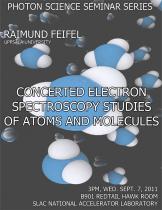Speaker: Raimund Feifel, Uppsala University
Program Description
The interpretation of the photoelectric effect by Albert Einstein in 1905 opened the way for photoelectron spectroscopy as developed in the mid 1950¹s by Siegbahn and coworkers in Uppsala. It reveals mainly the transitions to singly-ionised states of the system studied.
Photoabsorption may also lead to the ejection of two or more electrons from the same target species. If all the ejected electrons for a given process can be detected simultaneously and energy analyzed, the energy levels of the multiply-ionized system can be obtained. This experiment is in effect multi-dimensional electron correlation spectroscopy. One of today¹s most successful experimental techniques for this purpose is based on a long time-of-flight magnetic bottle electron spectrometer.
Since the advent of the Linac Coherent Light Source in Stanford as the world¹s first Free Electron Laser in the X-ray spectral region, unique possibilities are opened up for the studies of multiply-charged species. In particular, the interest in studying doubly core ionized systems has grown rapidly.
In this seminar novel techniques invented recently for multi-electron correlation spectroscopy will be presented. Examples of studies of double and higher order photoionisation of atoms and molecules will be given and mechanisms for multiple ionisation processes will be discussed as well as energy relationships.





